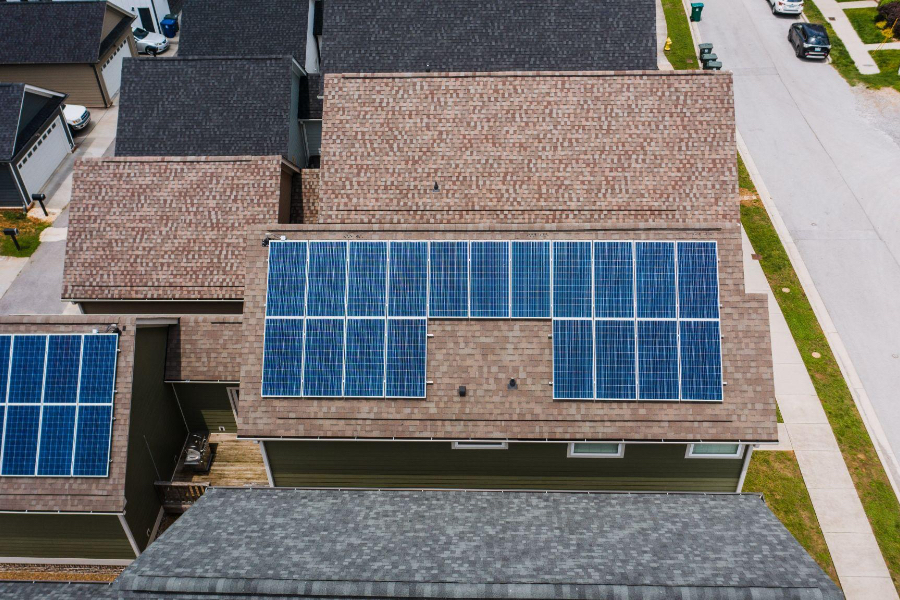PERC (passivated emitter rear contact) technology has been ruling the solar power industry for a long time. While it has a theoretical efficiency of around 24%, PERC technology is still lacking as it leads to recombination loss due to metal contact. For this reason, passivated contact technology has remained at the top of investigations into photovoltaics for several years. Within this technology field, there seems to be a top contender—TOPCon (Tunnel Oxide Passivated Contact) Solar Cells.
TOPCon is an advanced N-type silicon cell technology that helps mitigate recombination losses and increase cell efficiency. So, it’s no surprise that this technology is creating a buzz in the renewable energy industry.
Here is a complete guide to help businesses understand the ins and outs of TOPCon solar cells, and how they could revolutionize generating solar power.
Table of Contents
Global market summary of solar cells
The technology behind TOPCon solar cells
TOPCon solar cells: The greater benefits
Conclusion
Global market summary of solar cells
The solar cell market is experiencing massive traction worldwide, and it may reach a Compound Annual Growth Rate or CAGR of 17.72% between 2022 to 2030. In 2021, the solar cell market was about $85 billion; by 2030 it’s expected to exceed $369 billion.
These numbers are impressive due to the increase in concerns for the rising carbon footprints worldwide throughout different economic sectors. In the next seven years, demand is projected to rise due to an increased need for clean, environmentally friendly, and dependable sources that will drastically reduce reliance on fossil fuels.
In short, the solar cell market is currently competitive with other fuels because of its cost-effectiveness. Another key driver of this market is the growing investments in renewable energy sources for electricity, and government incentives like tariffs, tax breaks, etc., that encourages investments.
The technology behind TOPCon solar cells

Before we try to understand the technology behind TOPCon solar cells, let’s take a brief look at PERC technology–since the general scheme of a PERC and TOPCon solar cell are quite similar.
PERC solar cells feature an extra dielectric passivation layer at the back of the cell that captures more sun rays, reflecting them into the solar cell for conversion to electricity for increased efficiency. There are two types of PERC solar cells: -type and P-type.
The primary difference between a p-type and n-type PERC cell is in the atoms their silicon wafer is doped with, which affects their number of electrons. In p-type PERC cells, the silicon layer is doped with boron, meaning there is a deficit of one electron, making the cell positively charged. On the other hand, n-type PERC cells are doped with phosphorus, meaning an extra electron, making it negatively charged. In short, n-type PERC cells are usually more efficient than p-type cells.
Now, let’s move on to TOPCon solar cells.
TOPCon solar cells use a micro-nano tunneling oxide layer and an intrinsic, carrier-selective, polysilicon layer at the back. Also, a dielectric stack and an anti-reflection layer passivate the front end. Together, these components offer high-efficiency and cutting-edge passivation contact technology. The thin silicon layer serves as the surface passivation layer, enabling a two-way enhancement in passivation performance and electrical conductivity, which minimizes subsurface recombination.
TOPCon cells are similar to n-PERC solar cells. Hence, unlike other potential new technologies, existing PERC solar cells can be easily upgraded to TOPCon solar cells by adding a tunnel oxide passivation layer. This upgrade reduces the total cost of improving the efficiency of existing PERC lines and provides updated technological innovations.
TOPCon solar cells: the greater benefits
TOPCon is a promising solar cell technology that could replace other technologies in the industry, such as PERC/PERT and HJT, that is quickly inching toward their efficiency limit or come with significant long-term costs. Here are two vital benefits of TOPCon solar cells that could help it become mainstream in the near future.
High upper limit of efficiency
TOPCon solar cells prove to be an attractive option as businesses crave alternative solar cell technologies with low manufacturing costs, less-complicated procedures, and higher efficiency potential.
TOPCon solar cells feature N-type silicon, which offers both efficiency and stability, unlike other technologies in the solar power industry with issues like high LID and LeTID degradation.
Several studies have found the upper limit of theoretical efficiency for TOPCon solar cells to be around 28.2 to 28.7%. This efficiency is far greater than PERC cells, which stand at 24.5%. And a higher efficiency leads to more energy harvesting per unit area.

Adaptable manufacturing process
As stated earlier, TOPCon is much like a modified version of PERC cells. So, TOPCon solar cells can be easily manufactured by adding a few extra processes to the well-matured PERC manufacturing processes and product lines. This compatibility between the two technologies means that adopting the TOPCon technology is more accessible to those already using PERC cells.
Conclusion
TOPCon solar cells offer a combination of unparalleled efficiency, relatively low capital costs, and the capability to fit into existing module design parameters easily. While other n-type solar cell technologies like IBC and HJT exist, they demand unique cell lines and higher capital costs. Hence, TOPCon solar cells are worth considering..
Several solar module companies, including LONGi and TrinaSolar, have already updated their production lines, and more are planning to do so soon. So, the renewable energy industry can expect TOPCon to grow and become as universal as PERC technology.





 Afrikaans
Afrikaans አማርኛ
አማርኛ العربية
العربية বাংলা
বাংলা Nederlands
Nederlands English
English Français
Français Deutsch
Deutsch हिन्दी
हिन्दी Bahasa Indonesia
Bahasa Indonesia Italiano
Italiano 日本語
日本語 한국어
한국어 Bahasa Melayu
Bahasa Melayu മലയാളം
മലയാളം پښتو
پښتو فارسی
فارسی Polski
Polski Português
Português Русский
Русский Español
Español Kiswahili
Kiswahili ไทย
ไทย Türkçe
Türkçe اردو
اردو Tiếng Việt
Tiếng Việt isiXhosa
isiXhosa Zulu
Zulu